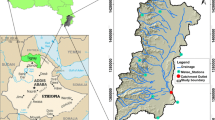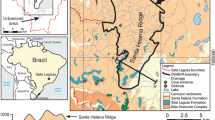Abstract
Groundwater is a major source of water use in Jeju volcanic island of Korea. Due to highly permeable surface conditions, the island does not have any perennial streams or rivers. Therefore, accurate estimation of groundwater recharge and understanding groundwater system are critical to make a reliable water budget in the island. A distributed quasi steady state water balance model, WetSpass (Water and Energy Transfer between Soil, Plants and Atmosphere under quasi Steady State) was adopted to estimate spatially-varying groundwater recharge considering soil type, land use, topography, and groundwater depth. The results from the study using weather data from October 2006 to September 2007 indicated that the eastern and northern parts of the island showed relatively higher rate of recharge as compared with the western region. A total of 69% of recharge occurred in the middle of the Island where topographic elevation is greater than 200 m from the mean sea level. The total amount of recharge was 1,935.6 million tons, 41.8% of the total precipitation. The higher rate of recharge was observed in the watersheds where forest and bare soil as land uses, and sandy loam and clay loam as soil types are dominant. The total runoff was 1,142.7 million tons (24.7%) and the total evapotranspiration was 1,555.7 million tons (33.5%). The zonal hydraulic conductivities estimated with groundwater flow modeling and parameter estimation process showed a wide range of values from 1.2 m/d to 5,380 m/d. The results of groundwater flow modeling indicated that the crest of groundwater table is off-centered from the peak of Mt. Halla toward south.
Similar content being viewed by others
References
Allen, R.G., Smith, M., Pereira, L.S., and Perrier, A., 1998, Crop evapotranspiration: guidelines for computing crop water requirements. FAO Irrigation and Drainage Paper, 56, FAO, Rome, 300 p.
Batelaan, O., 2006, Phreatology: Characterizing groundwater recharge and discharge using remote sensing, GIS, ecology, hydrochemistry and groundwater modeling. Ph.D. thesis, Vrije Universiteit Brussel, Brussel, 332 p.
Batelaan, O. and De Smedt, F., 2001, WetSpass: a flexibel, GIS based, distributed recharge methodology for regional groundwater modeling. Proceedings of a symposium on Impact of Human Activity on Groundwater Dynamics, The 6th IAHS Scientific Assembly, Maastricht, The Netherlands, July, IAHS Publication No. 269, 11–17.
Batelaan, O. and De Smedt, F., 2007, GIS-based recharge estimation by coupling surface-subsurface water balances. Journal of Hydrology, 337, 337–355.
Batelaan, O., Wang, Z., and De Smedt, F., 1996, An adaptive GIS toolbox for hydrological modeling. In: Kovar, K. and Nachtnebel, H.P. (eds), Application of Geographic Information Systems in Hydrology and Water Resources Management. Publication No. 235, IAHS, Wallingford, 3-9.
Batelaan, O. and Woldeamlak, S.T., 2007, Arcview Interface for WetSpass, User Manual. Version 13-06-2007. Department of Hydrology and Hydraulic Engineering, Vrije Universiteit Brussel, Brussel, 50 p.
Brunner, P., Bauer, P., Eugster, M., and Kinzelbach, W., 2004, Using remote sensing to regionalize local precipitation recharge rates obtained from the Chloride Method. Journal of Hydrology, 294, 241–250.
Carter, J.M. and Driscoll, D.G., 2006, Estimating recharge using relations between precipitation and yield in a mountainous area with large variability in precipitation. Journal of Hydrology, 316, 71–83.
Delin, G.N., Healy, R.W., Lorenz, D.L., and Nimmo, J.R., 2007, Comparison of local- to regional-scale estimates of ground-water recharge in Minnesota, USA. Journal of Hydrology, 334, 231–249.
Doherty, J., 2004, PEST: Model-Independent Parameter Estimation. Watermark Numerical Computing, Brisbane, Australia.
Fröhlich, K., Fröhlich, W., and Wittenberg, H., 1994, Determination of groundwater recharge by baseflow separation: regional analysis in northeast China. FRIEND: Flow Regimes from International Experimental and Network Data, Proceedings of Braunschweig Conference, October 1993, IAHS, 221, 69–75.
Geyer, T., Birk, S., Liedl, R., and Sauter, M., 2008, Quantification of temporal distribution of recharge in karst systems from spring hydrographs. Journal of Hydrology, 348, 452–463.
Hahn, J, Hahn, K., Kim, C., Kim, N., and Hahn, C., 1994., Sustainable Yield of Groundwater Resources of the Cheju Island. Journal of the Korean Society of Groundwater Environment, 1, 33–50. (in Korean with English abstract)
Hamm, S.Y., Cheong, J.Y., Jang, S., Jung C.Y., and Kim, B.S., 2005, Relationship between transmissivity and specific capacity in the volcanic aquifers of Jeju Island, Korea. Journal of Hydrology, 310, 111–121.
Harbaugh, A.W., Banta, E.R., Hill, M.C., and McDonald, M.G., 2000, MODFLOW-2000, The U.S. Geological Survey Modular Ground-Water Model — User Guide to Modularization Concepts and the Ground-Water Flow Process. Open-File Report 00-92, U.S. Geological Survey, Reston, 120 p.
Hwang, J.H., Lee, B.J., and Song, K,Y., 1994, Quaternary Tectonic Movement on Cheju Island. Economic and Environmental Geology, 27, 209–212. (in Korean with English abstract)
Jyrkama, M.I. and Sykes, J.F., 2007, The impact of climate change on spatially varying groundwater recharge in the grand river watershed (Ontario). Journal of Hydrology 338, 237–250.
Kim, K., Seong, H., Kim, T., Park, K., Woo, N., Park, Y., Koh, G., and Park, W., 2006, Tidal effects on variations of fresh-saltwater interface and groundwater flow in a multilayered coastal aquifer on a volcanic island (Jeju Island, Korea). Journal of Hydrology, 330, 525–542.
KOWACO, 2003, Comprehensive Investigation of hydrogeology and groundwater resources on Jeju Island III. Jeju Special Self-Governing Province, Korea Water Resources Coporation (KOWACO), Daejeon, 167 p. (in Korean)
Lee, B., Koo M., Park, Y., Koh, G., and Park, K., 2006a, Hydraulic diffusivity and possibility of conduit-flow of groundwater in eastern part of Jeju island. Journal of the Geological Society of Korea, 42, 439–454.
Lee, C., Chen, W., and Lee, R., 2006b, Estimation of groundwater recharge using water balance coupled with base-flow-record estimation and stable-base-flow analysis. Environmental Geology, 51, 73–82.
Lin, Y., Wang, J., and Valocchi, A., 2009, PRO-GRADE: GIS Toolkits for Ground Water Recharge and Discharge Estimation. Ground Water, 47, 122–128.
McDonald, M.G. and Harbaugh, A.W., 1998, A modular three-dimensional finite-difference ground-water flow model. Open-File Report 83-875, U.S. Geological Survey, Washington.
Moon, S., Woo, N.C., and Lee, K.S., 2004, Statistical analysis of hydrographs and water-table fluctuation to estimate groundwater recharge. Journal of Hydrology, 292, 198–209.
Park, K., 2006, Integrated Analysis of Groundwater Occurence in Jeju. Korea Institute of Geoscience and Mineral Resources, Daejeon, 182 p.
Shevenell, L., 1996, Analysis of well hydrographs in a karst aquifer: estimates of specific yields and continuum transmissivities. Journal of Hydrology, 174, 331–355.
Szliagyi, Z., Harvey, J., and Ayers, J., 2003, Regional Estimation of Base Recharge to Ground Water Using Water Balance and Base-Flow Index. Ground Water, 41, 504–513.
Sohn, Y.K., Park, K.H., and Yoon, S., 2008, Primary versus secondary and subaerial versus submarine hydrovolcanic deposits in the subsurface of Jeju Island, Korea. Sedimentology, 55, 899–924.
Stisen, S., Jensen, K.H., Sandholt, I., and Grimes, D.I.F., 2008, Aremote sensing driven distributed hydrological model of the Senegal River basin. Journal of Hydrology, 354, 131–148.
Tabbagh, A., Bendjoudi, H., and Benderitter, Y., 1999, Determination of recharge in unsaturated soils using temperature monitoring. Water Resource Research, 35, 2439–2446.
Taniguchi, M., 1994, Estimated Recharge Rates From Groundwater Temperatures In The Nara Basin, Japan. Hydrogeology Journal, 2, 7–14.
Valiantzas, J.D., 2006, Simplified versions for the Penman evaporation equation using routine weather data. Journal of Hydrology, 331, 690–702.
Welsh, W., 2008, Water balance modelling in Bowen, Queensland, and the ten iterative steps in model development and evaluation. Environmental Modelling & Software, 23, 195–205.
Won, J., 2004, Hydrogeologic investigation and hydrologic budget of groundwater resources on Jeju Island, Korea. Ph.D. thesis, Seoul National University, Seoul, 208 p.
Won, J., Kim, J., Koh, G., and Lee, J., 2005, Evaluation of hydrogeological characteristics in Jeju Island, Korea.Geosciences Journal, 9, 33–46.
Won, J., Lee, J., Kim, J., and Koh, G., 2006, Groundwater occurrence on Jeju Island, Korea. Hydrogeology Journal, 14, 532–547.
Author information
Authors and Affiliations
Corresponding author
Rights and permissions
About this article
Cite this article
Park, C., Seo, J., Lee, J. et al. A distributed water balance approach to groundwater recharge estimation for Jeju volcanic island, Korea. Geosci J 18, 193–207 (2014). https://doi.org/10.1007/s12303-013-0063-6
Received:
Accepted:
Published:
Issue Date:
DOI: https://doi.org/10.1007/s12303-013-0063-6




